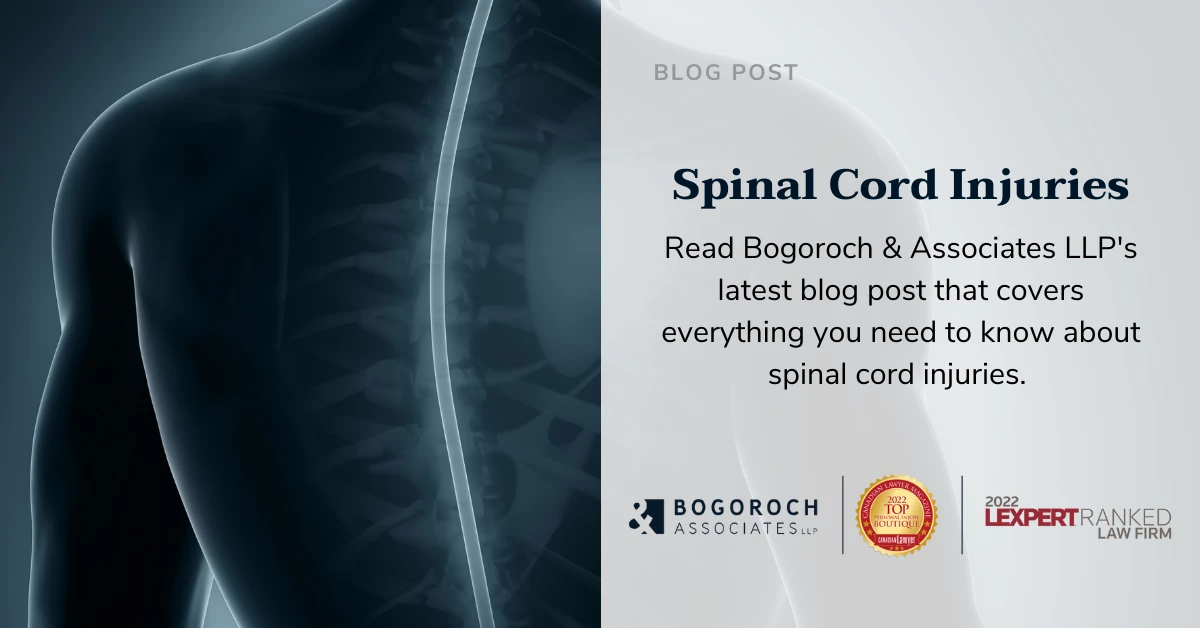A spinal cord injury refers to damage to the spinal cord resulting from trauma, disease, or degeneration.
Types of spinal cord injuries
There are two main types of spinal cord injuries: 1) complete; and 2) incomplete.
1) Complete Spinal Cord Injuries
A complete spinal cord injury causes permanent damage to the area of the spinal cord that is affected, resulting in paraplegia or tetraplegia. Paraplegia affects all or part of the trunk, legs, and pelvic organs. Tetraplegia affects the arms, hands, trunk, legs, bowel, and bladder.
2) Incomplete Spinal Cord Injuries
An incomplete spinal cord injury causes partial damage to the spinal cord. The ability to move and the amount of feeling depends on the area of the spine that is injured and the severity of the injury. Outcomes are also dependent on a patient’s health and medical history.
Incomplete spinal cord injuries account for over 60% of all spinal cord injuries. They may cause severe chronic pain.
Levels of spinal cord injuries
The section of the spine that is injured, namely the cervical, thoracic, lumbar, or sacral, impacts the level of a spinal cord injury.
- A cervical (C4) spinal cord injury is the most severe – it affects the head and neck region above the shoulders.
- A lumbar spinal cord injury affects the hips and legs. Individuals may require a wheelchair or walk with braces.
- A sacral spinal cord injury affects the hips, back of the thighs, buttocks, and pelvic organs. Individuals are most likely able to walk with this level of spinal cord injury.
- A thoracic spinal cord injury affects the upper chest, mid-back, and abdominal muscles. Arm and hand function is usually normal with this level of spinal cord injury.
Cervical and thoracic spinal cord injuries are the most common.
What is Brown-Séquard syndrome?
Brown-Séquard syndrome (BSS) is a rare neurological condition that occurs when damage to the spinal cord causes muscle weakness or paralysis on one side of the body and a loss of sensation on the opposite side. BSS is considered an incomplete spinal cord injury.
The most common cause of BSS is trauma, typically penetrating trauma such as a gunshot or stab wound. Other causes include inflammation or pinching of the spinal cord.
Common causes of spinal cord injuries
Most spinal cord injuries are trauma-based. Common causes include motor vehicle accidents, cyclist accidents, pedestrian accidents, sport and recreational accidents, and slip and falls.
According to the American Association of Neurological Surgeons, motor vehicle accidents are the leading cause of spinal cord injuries in younger individuals, while falls are the leading cause of spinal cord injuries in people over age 65.
Spinal cord injuries and Statutory Accident Benefits in Ontario (“SABS”)
If you are involved in a car accident in Ontario and you suffer injuries (including if you suffer a spinal cord injury), you are entitled to no-fault statutory accident benefits, commonly referred to as SABS, through your automobile insurance policy. If you do not have a car insurance policy, you are entitled to claim these benefits from the insurer of the vehicle in which you were a passenger, or the insurer of the vehicle that struck you if you were a pedestrian or cyclist.
The SABS provides access to benefits, such as income replacement benefits, and medical, rehabilitation and attendant care benefits, as well as several other expenses. For medical, rehabilitation and attendant care benefits, you will be placed within one of the following categories:
- Minor-Injury Guideline – you will have $3,500.00 of available coverage
- Non-Catastrophic Injury – you will have $65,000.00 of available coverage
- Catastrophic Injury – you will have $1,000,000 of available coverage
To be placed in the Catastrophic Injury category, the individual must meet the catastrophic impairment criteria. Paraplegia or tetraplegia satisfies this criteria. Thus, if an individual was involved in a car accident on or after June 1, 2016 and they sustained a complete spinal cord injury that resulted in paraplegia or tetraplegia, they would be deemed catastrophically impaired.
Spinal Cord Injury Lawyers
Very few injuries are more serious than those involving the spinal cord. Whether a car accident causes them, a slip and fall, or medical malpractice, victims require constant care and attention. Their quality of life, and that of family members, changes drastically.
Our role is to ensure that you are justly compensated for all resulting damages, including:
- pain and suffering;
- loss of enjoyment of life;
- home and/or vehicle modification;
- future health care costs;
- personal care and support systems; and
- loss of income and other economic losses.
Our experienced Spinal Cord Injury Lawyers will advocate vigorously on your behalf and help you every step of the way. We will make sure your case is managed effectively and promptly. Our team will work closely with top medical professionals and experts to guide you through the justice system with knowledge, commitment, and compassion because the only acceptable outcome for us is the best possible settlement for you.
Bogoroch & Associates LLP is experienced in all aspects of personal injury and medical malpractice litigation. We have the confidence and skill to advance your motor vehicle accident or medical malpractice claim to settlement or trial while helping you navigate the complex medical, legal, and insurance issues.
Our experience, commitment to excellence, and reputation have long been recognized. Our founding partner, Richard M. Bogoroch, has been recognized as a leading personal injury lawyer by The Canadian Legal Lexpert Directory and by The Best Lawyers in Canada. The Canadian Legal Lexpert Directory and The Best Lawyers in Canada are two highly regarded lawyer rating publications.

